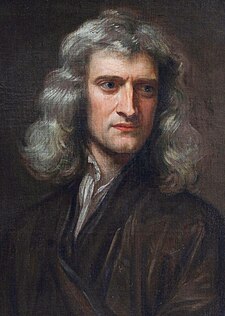Isaac Newton
| Sir Isaac Newton | |
|---|---|
 Godfrey Kneller's 1689 portrait of Isaac Newton (aged 46) | |
| Ìbí | 4 Oṣù Kínní 1643 [OS: 25 December 1642][1] Woolsthorpe-by-Colsterworth Lincolnshire, England |
| Aláìsí | 31 March 1727 (ọmọ ọdún 84) [OS: 20 March 1727][1] Kensington, Middlesex, England |
| Ibùgbé | England |
| Ará ìlẹ̀ | English |
| Ọmọ orílẹ̀-èdè | English (British from 1707) |
| Pápá | physics, mathematics, astronomy, natural philosophy, alchemy, theology |
| Ilé-ẹ̀kọ́ | University of Cambridge Royal Society Royal Mint |
| Ibi ẹ̀kọ́ | Trinity College, Cambridge |
| Academic advisors | Isaac Barrow[2] Benjamin Pulleyn[3][4] |
| Notable students | Roger Cotes William Whiston |
| Ó gbajúmọ̀ fún | Newtonian mechanics Universal gravitation Calculus Optics |
| Influences | Henry More[5] Polish Brethren[6] |
| Influenced | Nicolas Fatio de Duillier John Keill |
| Religious stance | Arianism; for details see article |
| Signature | |
Isaac Newton (tí wọ́n bí ní Ọjọ́ kẹrin oṣù kìíní ọdún 1643 - ọjọ́ kọkànlélọ̀gbọ̀n oṣù kẹta 1727) jẹ́ onímọ̀ sáyẹ́nsì ọmọ orílẹ̀-èdè Gẹ̀gẹ̀ẹ́sì. Ó jẹ́ amọ̀ye ninu ẹ̀kọ́ ìsirò, awòràwọ̀, ẹ̀sìn àti ònkòwé. Ní ìgbà ayé rẹ̀, wọ́ń mọ si amọ̀ye ohun gbogbo. Látìnì: Philosophiæ Naturalis Principia Mathematica, ìwé ti ó kọ ní ọdún 1687 jẹ́ ìpìlẹ̀ fun ìsisẹ́ẹ̀ro ayébáyé (nínu ẹkọ́ọ físíìsì). Ìwé yìí wà nípa òfin ìsirò lóri ìmọ̀ye ìṣẹ̀dá, ó sìm jẹ́ awọn ofin akọ́kọ́.

|
Àyọkà yìí tàbí apá rẹ̀ únfẹ́ àtúnṣe sí. Ẹ le fẹ̀ jù báyìí lọ tàbí kí ẹ ṣàtúnṣe rẹ̀ lọ́nà tí yíò mu kúnrẹ́rẹ́. Ẹ ran Wikipedia lọ́wọ́ láti fẹ̀ẹ́ jù báyìí lọ. |
Itokasi[àtúnṣe | àtúnṣe àmìọ̀rọ̀]
- ↑ 1.0 1.1 During Newton's lifetime, two calendars were in use in Europe: the Julian or 'Old Style' in Britain and parts of northern Europe (Protestant) and eastern Europe, and the Gregorian or 'New Style', in use in Roman Catholic Europe and elsewhere. At Newton's birth, Gregorian dates were ten days ahead of Julian dates: thus Newton was born on Christmas Day, 25 December 1642 by the Julian calendar, but on 4 January 1643 by the Gregorian. By the time he died, the difference between the calendars had increased to eleven days. Moreover, prior to the adoption of the Gregorian calendar in the UK in 1752, the English new year began (for legal and some other civil purposes) on 25 March ('Lady Day', i.e. the feast of the Annunciation: sometimes called 'Annunciation Style') rather than on 1 January (sometimes called 'Circumcision Style'). Unless otherwise noted, the remainder of the dates in this article follow the Julian Calendar.
- ↑ Mordechai Feingold, Barrow, Isaac (1630–1677), Oxford Dictionary of National Biography, Oxford University Press, September 2004; online edn, May 2007; accessed 24 February 2009; explained further in Mordechai Feingold " Newton, Leibniz, and Barrow Too: An Attempt at a Reinterpretation"; Isis, Vol. 84, No. 2 (June, 1993), pp. 310-338
- ↑ Dictionary of Scientific Biography, Newton, Isaac, n.4
- ↑ Gjersten, Derek (1986). The Newton Handbook. London: Routledge & Kegan Paul.
- ↑ Westfall, Richard S. (1983) [1980]. "Never at Rest: A Biography of Isaac Newton. Cambridge: Cambridge University Press. pp. 530–1. ISBN 0521274354, 9780521274357.
- ↑ Snobelen, Stephen D. (1999). "Isaac Newton, heretic: the strategies of a Nicodemite" (PDF). British Journal for the History of Science 32: 381–419. doi:10.1017/S0007087499003751. Archived from the original on 2013-10-07. https://web.archive.org/web/20131007005450/http://isaac-newton.org/heretic.pdf. Retrieved 2009-11-20.
| Wikimedia Commons ní àwọn amóunmáwòrán bíbátan mọ́: Isaac Newton |
